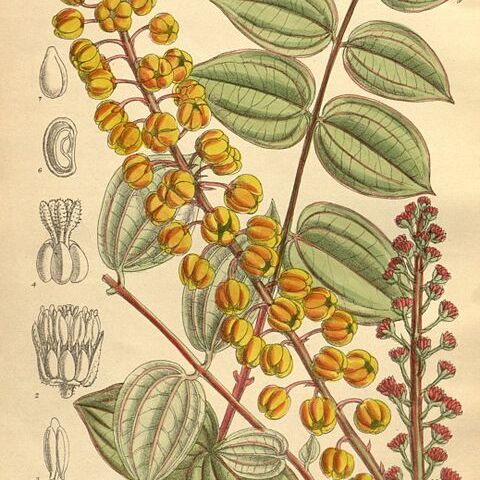Herbs subshrubby, 0.5-1 m tall; branches few; branchlets tetragonous or slightly narrowly winged, purplish glandular pubescent. Leaves sessile or shortly petiolate; leaf blade: lower ones broadly ovate or almost orbicular, 4-6(-7.5) × 3-5 cm, upper ones or those on lateral branches ovate-lanceolate or oblong-lanceolate, 2.5-4 × ca. 1.5 cm, papery, both surfaces glan-dular pubescent, basally (3-)5-9-veined, base cordate and semiamplexicaul or subrounded, margin glandular ciliate, apex acute or rounded, mucronate at tip. Raceme terminal, 12.5-21 cm; rachis purplish red, white glandular pilose. Flowers small, unisexual and plant monoecious; bracts purple, lanceolate, 3-4 mm. Pedicel 3-6 mm, elongated to 1.2 cm at fruiting, glandular pilose. Sepals broadly ovate, ovate, or ovate-lanceolate, 2.5-3 × 1.3-2.5 mm, outside grayish white puncticulate, margins translucent, apex acuminate or acute. Petals ovate, small, 1-1.5 × ca. 0.6 mm, fleshy, enlarged after anthesis. Filaments linear, ca. 0.8 mm; anthers oblong, 2-2.5 mm. Carpels 5, laterally compressed, ca. 1 mm; styles short; stigma ca. 2 mm. Fruit purplish red to black when mature, 2.5-3 mm in diam. Fl. May-Jun, fr. Jul-Sep. 2n = 40.
More
A deciduous shrub. It has rhizomes or underground stems. It grows 1.5 m tall. The leaves have leaflets along the stalk. The leaflets are 8 cm long. The flowering stalks are on the tips of the branches. They can be 15 cm long. The fruit is large and black. They can be red.
It is a warm temperate and subtropical plant. In southern China it grows on mountain slopes between 1,800-3,700 m above sea level. It suits hardiness zones 8-10. In Sichuan and Yunnan.
More
Thickets and woodland margins, 2000-2600 metres in W. China.

